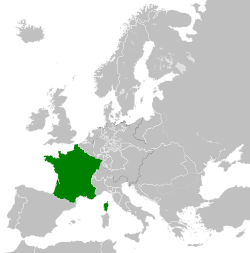This article has multiple issues. Please help improve it or discuss these issues on the talk page. (Learn how and when to remove these messages)
|
French Republic République française (French) | |||||||||
|---|---|---|---|---|---|---|---|---|---|
| 1848–1852 | |||||||||
| Motto: Liberté, Égalité, Fraternité "Liberty, Equality, Fraternity" | |||||||||
| Anthem: Le Chant des Girondins "The Song of Girondists" | |||||||||
 The French Republic in 1848 | |||||||||
| Capital | Paris | ||||||||
| Official languages | French | ||||||||
| Religion | Roman Catholicism (State religion) Calvinism Lutheranism Judaism | ||||||||
| Demonym(s) | French | ||||||||
| Government | Unitary semi-presidential republic (1848–1851) Unitary presidential republic under a dictatorship (1851–1852) | ||||||||
| President | |||||||||
• 1848–1852 | Prince Louis-Napoleon Bonaparte | ||||||||
| Vice President | |||||||||
• 1849–1852 | Henri Georges Boulay de la Meurthe | ||||||||
| Prime Minister | |||||||||
• 1848 (first) | Jacques-Charles Dupont | ||||||||
• 1851 (last) | Léon Faucher | ||||||||
| Legislature | National Assembly | ||||||||
| History | |||||||||
| 23 February 1848 | |||||||||
| 27 April 1848 | |||||||||
| 4 November 1848 | |||||||||
| 2 December 1851 | |||||||||
• Establishment of the Second Empire | 2 December 1852 | ||||||||
| Currency | French Franc | ||||||||
| |||||||||
| Today part of | France Algeria | ||||||||
The French Second Republic (French: Deuxième République Française or La IIe République), officially the French Republic (République française), was the second republican government of France. It existed from 1848 until its dissolution in 1852.
Following the final defeat of Napoleon Bonaparte at the Battle of Waterloo, France had been reconstituted into a monarchy known as the Bourbon Restoration. After a brief period of revolutionary turmoil in 1830, royal power was again secured in the "July Monarchy", governed under principles of moderate conservatism and improved relations with the United Kingdom.
In 1848, Europe erupted into a mass revolutionary wave in which many citizens challenged their royal leaders. Much of it was led by France in the February Revolution, overthrowing King Louis-Philippe.[1] Radical and liberal factions of the population convened the French Second Republic in 1848. Attempting to restore the First French Republic's values on human rights and constitutional government, they adopted the motto of the First Republic; Liberté, Égalité, Fraternité. The republic was plagued with tribalist tendencies of its leading factions: royalists, proto-socialists, liberals, and conservatives. In this environment, Napoleon's nephew, Louis-Napoléon Bonaparte, established himself as a popular anti-establishment figure and was elected president in 1848.
Under the Second Republic's constitution, the president was restricted to a single term. Louis-Napoléon overthrew the republic in an 1851 self-coup d'état, proclaimed himself Emperor Napoleon III, and created the Second French Empire.
- ^ "Second Republic | French history | Britannica". www.britannica.com. Retrieved 14 July 2022.

